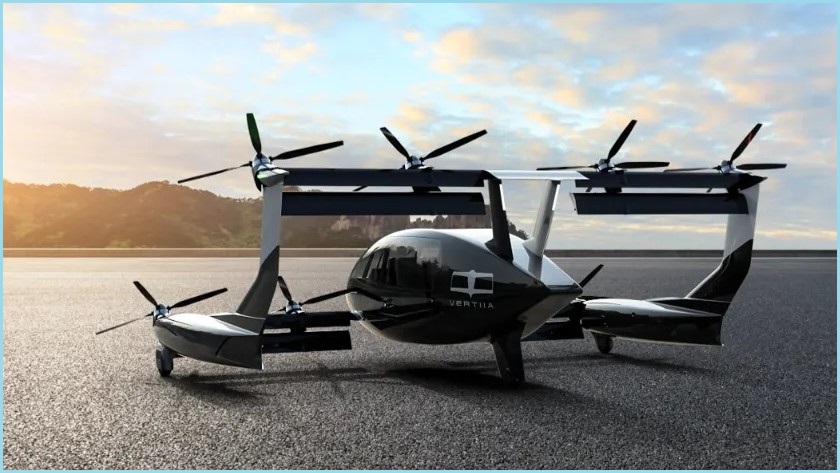Flying electric vehicles could drastically change how Australians live by connecting capital cities with the regions – and it’s a future that might not be as far off as you think.
That was the message from a panel at South by Southwest Sydney (SXSW) last week where a small crowd was encouraged to imagine commuting to work in the transport technology of the future: electric vertical take-off and landing (eVTOL) vehicles.
eVTOLs are what Uber was promising would pick customers up from rooftops in Melbourne’s CBD and take them out to Tullamarine airport when it said it would bring flying taxis to Australia (before selling off its Elevate division in 2020).
Think quadcopter drones big enough to seat a couple of passengers and a pilot.
One day they might even fly themselves.
This is the closest humans have yet gotten to engineering flying cars, and for Andrew Moore, CEO of Australian eVTOL company AMSL Aero, it represents a lifetime of invention and dreaming.
“My mother has kept a sketchbook from when I was seven years old, it’s a little bit embarrassing, but I certainly have been thinking about the problem of transport around Australia for a long time,” he told the SXSW audience.
“I grew up on a farm in rural New South Wales where there were lots of small planes doing crop dusting and the bank run, and delivering medical pathology samples or newspapers. So I was immersed in aviation for a long time.”
While aircraft have been an important part of rural life for the best part of 100 years, we’re on the cusp of a new era of flight in which eVTOLs pick up and drop passengers off at vertical take-off airports – vertiports – scattered around communities and connecting Australia’s increasingly populated capital cities with regions using minimally expensive infrastructure.
The Civil Aviation Safety Authority has started drafting guidelines for vertiport design which suggests the infrastructure needed for eVTOLs is on its way.
“Our current paradigm of aviation is airport to airport,” said Dale Sheridan, the engagement lead with Invest Victoria’s Advanced Air Mobility arm.
“If you want to fly somewhere you go to Sydney Airport, that’s a $10 billion asset, and you get on a plane with 150 other people and fly to another $10 billion asset,”
“There’s a whole part of the journey before and after, so I guess it’s about filling the gaps of existing transport networks.
“Do I think it’s going to take over Sydney to Melbourne [flights]? No, but I think there’s so much of the country that doesn’t have these transport connectivity options.”
Moore and the AMSL team have been working on a prototype for the Vertiia, an Australian-designed and built eVTOL earlier this year, and successfully conducted 11 tethered test flights.
He said the company hopes to have its aircraft “commercially available well before the end of this decade”.
Changing health care in the regions
Vertiia intended to have a top speed of 300km/h and room for cargo, four passengers, or a stretcher for aeromedical flights – a use-case Dr Sarah Turner, a pre-hospital and retrieval specialist for CareFlight, said she’s particularly excited about.
Over the last three years aboard a medical helicopter, Dr Turner has seen a serious gap in healthcare availability in rural Australia.
“You can turn up to a country town that's three hours’ drive from Sydney which might have one GP who does a little bit of critical care in that town,” she told the SXSW audience.
“There is no pathology there on a daily basis; there is no way to get an X-ray done. If you need critical care, intensive care, anaesthetic or an operating theatre, you drive to the nearest major hospital.
“And if you're seriously unwell and the ambulances can't take you there, then you get an aeromedical team with a doctor, paramedic or a nurse come get you and that may take five or six hours depending on the availability of the aircraft.”
Six hours is a long time to get a critically-ill patient stabilised and into hospital, and is only made worse by the need for large aeromedical helicopters to land in airports where they meet ambulance crews.
“Having an eVTOL fly directly to a patient wherever they are, whether it's a hospital or a car accident on the side of the road, would give us those critical moments back,” Dr Turner said.
“There is a huge avenue for us to be able to do the things that we need to do to give health equity back to people all over Australia.”
For the time being, we’re still waiting for the technology, regulatory environment, and broader industry to develop but we may soon see regional towns designed around vertiports from which locals can quickly zip off and land in a big city half an hour later.
There are even designs for personal eVTOLs that can drive on the road, like the ASKA A5, a California-designed craft with propellors and wings that can fold up to theoretically let you drive from your home, to a vertiport, and off to your next destination.
It’s not cheap, either with pre-orders for the A5 selling for US$789,000 (around $1.2 million) inclusive of pilot licence training.
For Sheridan, these futuristic modes of transport “will live and die” depending on how affordable and accessible they become.
“If it’s too expensive, then people simply won’t use it,” she said.
“Similarly, if it is inconvenient to access, like if you have to go to the airport where there’s extra security and you have to deal with more people and traffic, then that will serve as a disincentive to uptake.”










